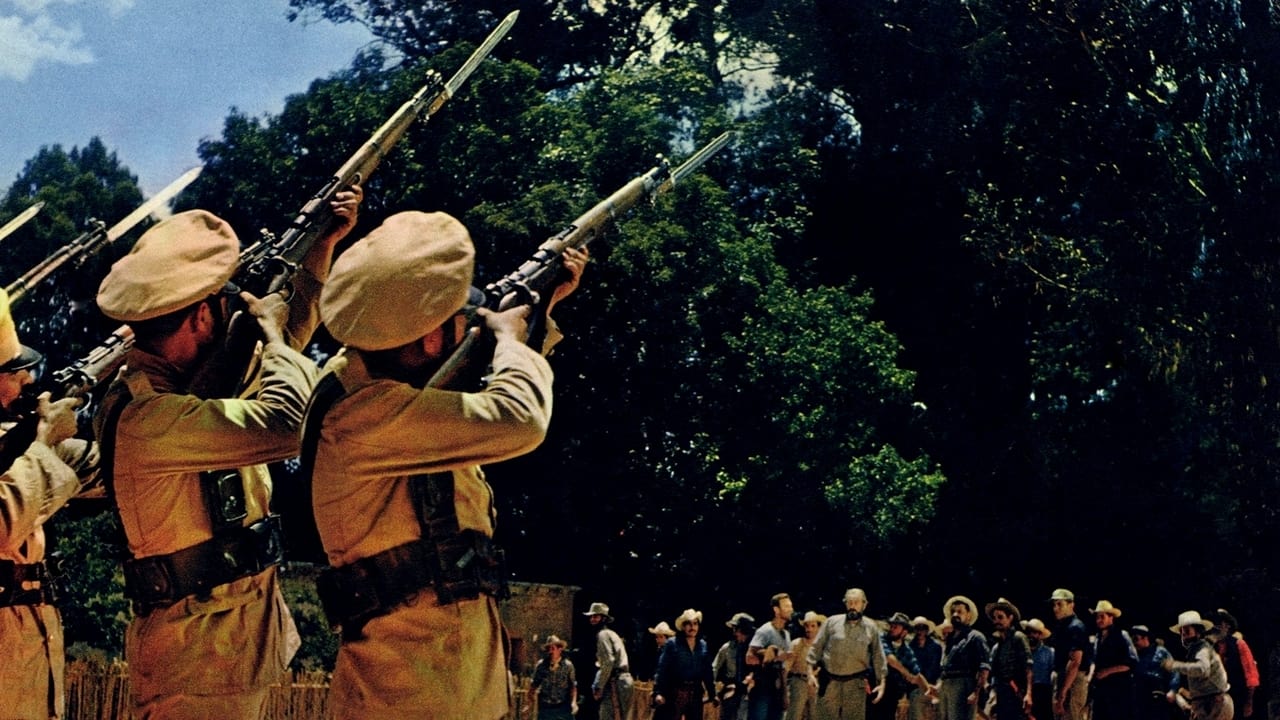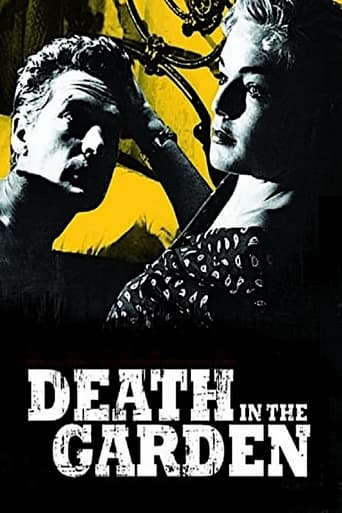

just watch it!
... View MoreHow sad is this?
... View MoreIt’s an especially fun movie from a director and cast who are clearly having a good time allowing themselves to let loose.
... View MoreEach character in this movie — down to the smallest one — is an individual rather than a type, prone to spontaneous changes of mood and sometimes amusing outbursts of pettiness or ill humor.
... View MoreBunuel doing an adventure movie is fine in my book. Why do people have to be such snobs when it comes to pigeonholing directors? Some of the films Bunuel made during this period, he may have been personally disappointed because he might have rather been making pix with subject matter more of his choosing. Nevertheless the things that Bunuel brings to this movie - the subtle deadpan humor throughout, the irreverent politics, the surreal touches (especially in the last third of the film when our fugitive protagonists are in the jungle) -- make this a gem. Plus Georges Marchal, Charles Vanel and Michel Piccoli are stupendous. And Signoret is in a class by herself. Not only was she one of the most stunningly gorgeous and sexy actresses in movies anywhere in the world in the 1950s, she was also a great actress and perfect here as the unrepentant, mercenary whore who falls in love. The last jungle sequence has some of the most beautifully surreal images in any film from the decade. The new DVD is highly recommended. A really perfect balance of elements.
... View MoreUnderseen Bunuel movie starring Simone Signoret and Michel Piccoli, among others. These two, playing a prostitute and a priest respectively, are joined by Charles Vanel, Georges Marchal and Michele Girardon as a group of people in South America trying to escape an oppressive government. Marchal and Vanel, both diamond miners, are two men taken as revolutionaries by those in charge. The first half of the movie is about their getting into trouble, and their attempt to find a way out of the country. The second, and more interesting half takes place in the jungle, where the group gets stranded during their escape attempt. Many of Bunuel's pet themes come up, and there's a lot of his signature visual trademarks. The most potent image is that of a python Marchal kills with a machete, thrown down to the ground while they try to start the fire. Piccoli looks over at it and its corpse is writhing with fire ants. It's a pretty good story, very gripping in its latter half. It may not rank alongside Bunuel's best, but it's certainly a worthy film in his canon.
... View MoreCONTAINS SPOILERS .CONTAINS SPOILERS;CONTAINS SPOILERSAt first sight,"la Mort en Ce Jardin" looks like an adventure yarn for the whole family,but I hope the grown-ups are old enough to know better;it's for sure a very accessible work,when compared to former ones (un chien andalou,los hurdes,el)but do not believe the great Spanish director has lost his bite:even when he filmed "Robinson Crusoe" (another "family movie"?),Bunuel's obsessions surfaced.What puzzles the spectator is the big budget:scope,colors(and the cinematography in the second part is absolutely enthralling),big French stars (Simone Signoret and Charles Vanel ,fresh from Clouzot's "les diaboliques",George Marshall,and also Michel Piccoli who ,though by no means at the beginning of his career,was not very known yet),and a score by Paul Miraski,one of Edith Piaf's favorite composers.There are two jungles:the first one is Man Jungle.Its predators are the military men,its bitter fruit is religion.As the colonels humiliate,forbid,imprison,torture and kill,the priests-here represented by father Lizzardi(Piccoli)-urge the population to resign themselves to it.This priest character is very important,because he is the rough draft of what will be completely fulfilled two years later in "Nazarin"-"La Mort en Ce Jardin" will seem more relevant if you know the 1958 film-You've got to see Piccoli,bringing religious consolation to the prisoners in their dungeon:The raider Chark (Marshall ),who is practical-minded -and who's thus akin to "Viridiana"'s cousin in the 1961 masterwork- will pretend he take the priest's holy writ seriously,only in order to escape.But the best scene in which Bunuel shows his true face is the one in the church.Chark, prisoner led by the soldiers ,walks across a church where Lizzardi is celebrating mass:with his gun,one of the soldiers forces him to kneel down.Later another character will tell the priest that everywhere he and his religious mates come,begins the exploiters'reign.This first part has often be criticized,because they say it moves too slow,but it's necessary to make acquaintance with the main characters ,who will leave the first jungle for the second one:outside Lizzardi and Chark,we have an old man( Vanel),who's forced to escape because the army thinks he is an agitator,his mute daughter,and a prostitute Djinn (Signoret,at her bitchiest).The second part has been praised quite rightly so.Bunuel succeeded in creating a stifling atmosphere full of animal noises -the music is totally absent here and will come back only for the last shots-.The astounding cinematography enhances a green hell garden and these who thinks Bunuel completely jettisoned his surrealistic art should have a second look at it:because it is HERE,even if it's fleetingly.I will take four examples:the first one is the Paris postcard:for a very short while,we do believe the fugitives are back in their dear country;the second one is the snake eaten by ants (seen through the priest's eyes).There's more to the picture than meets the eye:the plane which had crashed in the jungle and which will save some of the characters acquires a surrealistic dimension."God has saved us!" the priest tells.But the raider is not fooled:"it took fifty people's lives (the plane passengers) to save us!".But the most extraordinary picture is Signoret,in the jungle,wearing an evening gown,complete with bright jewels,she's found in the plane.Here again,the priest will be completely helpless,his bible can only be used to light a fire (always Bunuel's practical mind).And Bunuel's religious disgust reaches a climax when the old man goes crazy and yells that God has cursed them .That work ,generally regarded as a minor Bunuel work,is actually extremely intriguing.Although it has not the strength of such works as the ones I mention above ,it includes almost all his recurrent features.Adapted from a José André Lacour novel,dialogue by Raymond Queneau,who wrote "Zazie dans le métro",which Louis Malle transferred to the screen in 1960.
... View MoreI love most of Bunuel's films but "Death In the Garden" is definitely my absolute favorite, ahead of "Los Olvidados," and even "Viridiana." For me, this is as close to perfection as you can get doing 'transcendent realist' or 'transcendent existentialist' cinema (although Bunuel has gotten tagged as a 'surrealist,' most of his '50s work actually has very little to do with that movement and style, and a couple of 'trippy' scenes here and there shouldn't automatically serve to qualify those films in the same boat as "The Exterminating Angel" or "Phantom of Liberty," etc.). To most critics, when they even bother to mention this great film in talking about Bunuel, this is nothing but a 'flawed' film, a commercial chore or 'assignment.' To that I'll have to say: "If only 1 out of a 100 commercial 'chores' ended up as fascinatingly timeless as "Death in the Garden," the cinema would go through a major cultural revival!" The 'flaws' in this film are further aspects of its pefection, if taken in the proper 'absurdist' perspective the film has toward 'reality.' It has its lunatic elements and a few supernatural angles like all Bunuel films, but it also showcases the 'romantic' side of the man too often labeled a pessimist. By 'romantic' I mean, he's managed to fit his auteurist obsessions within a colorful, picturesque film about amoral adventurers in the Amazon jungle who descend into 'the Heart of Darkness.' Also, for one thing, there is some twisted heroism, or 'anti-heroism' going on here. The completely 'amoral' yet not unadmirable Georges Marchal character "Shark" is the closest thing to an Yves Montand/Wages-of-Fear type tough-guy 'hero' Bunuel ever got. On the surface "Death in the GArden" is a "Wages of Fear" like adventure story (Charles Vanel from Clouzot's masterpiece is one of the main characters) where a bunch of people are put under pressure and forced to work together and survive. The people putting the pressure on are the military fascists not the industrialist-fascists of "Wages of ear." The story happens in a South American state, where a bunch of Diamond miners are being chased out by the corrupt military government. When a small-scale civil war breaks out, the leaders of the rebels become hunted men, and they have to escape by boat, ending up in a rain-soaked amazon jungle trying to get to Brazil. The characters have to cooperate and survive under an increasingly hopeless situation and reveal fascinating aspects of themselves in the process. To incorporate Bunuel's anti-clerical satire, of course, one of them is a Nazarin-like priest, brilliantly portrayed by a very young Michel Piccoli. And like all Bunuel films, there are no moral black and whites to be found anywhere, no stereotypes, but only a dynamically evolving morality shaded in different grays leaning toward the black here, toward the white there, depending on the situation that's being dealt with. You come to have a deep level of sympathy with almost every rogue main character in the film, even Simone Signoret's avaricious Madame, but only after examining them as totally flawed human beings capable of many bizzare deeds, some admirable, others despicable, etc.Like most of Bunuel's films, "Death in the Garden" gets its main tone , originality, relevance, and philosophical strength from the hilariously absurd farcical scenes that constantly frustrate the action (but not in a totally irrational way as in the later allegorical, surrealist films), a deep identification with religion in order to remain that much more strongly anticlerical, and a complete lack of sentimentality; unlike most other Bunuel, this one has ravishingly beautiful color cinematography (very lush and colorful, almost Renoir-like, Renoir being an obvious favorite of Bunuel's since he not only re-made "Diary of a Chambermaid," but used Zachary Scott from "The Southerner," as his lead actor in "The Young One," his, in some ways Southerner-like foray into and artistic, if not commercial, conquest of American Cinema). Oh yeah! Did I mention the beautiful young deaf girl whose long hair gets stuck in a tree?! What more could you want? This is definitely a MASTERPIECE film that should be transferred to a good DVD as soon as feasible. The Interama video copy uses a scratchy old print, is not letterboxed, and has readable but ugly subtitles; yet, the beauty of this film comes through even in that format.
... View More